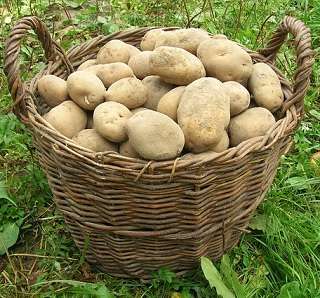Present and Past Perfect Tense Practice
We use the past perfect tense in English to tell what happened before another past event. The present perfect describes something that began in the past and is still continuing. Both help make the order of events clearer.
We form them using the verb have (‘have’ or ’has’ for the present perfect, ‘had’ for the past perfect) plus the past participle of the main verb. (Sometimes we add modals before 'have,' or continuous forms after it. See Past and Present Perfect Tense Use if you would like more details or examples.)
You can practice these tenses by filling in the blanks (gaps) in an essay about potatoes and world history.
Practice the Present and Past Perfect Tenses
Fill in the blanks in the paragraphs below. Use the past participles (or past participle + present participle: been+ _______ing) listed above each group of paragraphs.
For group 1:
become, been, been eating, called, disappeared, seen, spread, traced
 Potatoes have been eaten in South America for centuries. By the 16th century the Spanish had brought them to Europe, and by the 1840s they had become essential in the diet of Irish peasants.
Potatoes have been eaten in South America for centuries. By the 16th century the Spanish had brought them to Europe, and by the 1840s they had become essential in the diet of Irish peasants.People in the Andes region of South America have _____ _______ potatoes for thousands of years. People in Ireland and other parts of Europe had never even ________ a potato until the late 16th or early 17th centuries, years after the Spanish conquest of Peru.
So why have English-speaking people so
often ________ white (as compared to sweet) potatoes “Irish” potatoes? It’s an interesting story, with a lot of
drama.
Historians have _________ the route the “Irish” potato took to reach Ireland. From the Spanish colony of Peru in South America, potatoes were taken to Spain as food for sailors. Beginning around the middle of the 16th century (1500s), potatoes had _________ slowly through Europe. By the late 1700s, they had _________ adopted by many Europeans as a useful crop.
Initial distrust and fear had slowly ____________ as people recognized the advantages of potatoes. They found that potatoes added nutrients to soups and stew. Potatoes prevented famine when grain crops failed or soldiers stole all they could carry off.
(Europe had very frequent wars from the late 16th century through the early 19th century. Potatoes can be stored in the ground, since they are a root crop, so they are not so easy to steal.) By the early 19th century, potatoes had _________ a “safety net.”
Group 2: become, been, been (2x), been surviving, been working, caused, come, had, preserved returned, used
Potatoes have ________ some other major advantages over grain crops. They are easier to grow and prepare. They provide more food value-- a higher percentage of calories-- from a small amount of land than any other major food crop.
By the mid 1800s, historians believe potatoes had _________ or contributed to a large increase in European population, as they prevented famine and allowed more people to survive on less land.
They had __________ a staple in the diet of Irish and eastern European peasants. In fact, due to changes in land policy, by the 1840s many Irish peasants had ______ ___________ on just potatoes and milk.
Then tragedy struck. Starting in 1845, potato blight (a kind of fungus) destroyed a large percentage of the potato crop in Ireland and elsewhere. The socio-political situation was worse in Ireland. Many people there had no access to other foods or resources. Thousands died, and many more had to leave Ireland with nothing.
There had ________ Irish in the U.S. since the colonial period. Still, most Irish-Americans today can trace their families’ roots back to that mass immigration caused by the potato famine.
Over the years since the mid-19th century, scientists have ___________ to the Andes to find and develop more blight-resistant varieties of potatoes. The native Andean populations have always ________ many varieties of potato. Each has different characteristics including its climate tolerance and disease resistance.
The potato disaster in Ireland and Europe was far worse because the whole potato crop had ________ from those few potatoes brought to Europe so long ago. The Irish and European peasants had no access to the blight-resistant varieties growing in South America.
Many more varieties are available now, and potatoes are a major crop in much of the world. In fact, a survey of current use shows that the greatest potato production is now in China, followed by India.
Potatoes are mostly grown in the countries where they are used rather than for export. That's because they are difficult to store. They spoil easily if they have ________ kept in less-than-ideal conditions.
Researchers have ______ _________with the farmers of the Andes to ensure biodiversity. They have ____________, and continue to grow, a great number of varieties. In that way, there will always be some kinds to survive if a major disease destroys others. We don’t want to take the potato for granted again!
* Information sources: Cambridge.org “Potatoes,” History-magazine.com “potato,” & Wikipedia “Potato.”
For more information on crops that come from the Americas (as well as crops originating in the Old World) see this Simple English Wikipedia article on the Columbian Exchange.
Answers to the Present and Past Perfect Tense Practice.
Home> English Verb Tenses > Present and Past Perfect Tense Practice.
Didn't find what you
needed? Explain what you want in the search box below.
(For example, cognates, past tense practice, or 'get along with.') Click to see the related pages on EnglishHints.
| site search by freefind | advanced |





